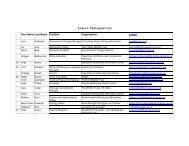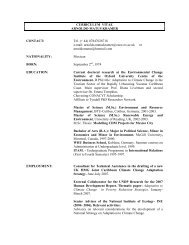ECI Annual Review 2006/2007 - Environmental Change Institute ...
ECI Annual Review 2006/2007 - Environmental Change Institute ...
ECI Annual Review 2006/2007 - Environmental Change Institute ...
You also want an ePaper? Increase the reach of your titles
YUMPU automatically turns print PDFs into web optimized ePapers that Google loves.
Pan-Amazonia Project: for the<br />
Advancement of Networked Science<br />
in Amazonia<br />
Pan-Amazonia is an interdisciplinary<br />
research project coordinated by<br />
the <strong>ECI</strong> and supported by the European<br />
Commission under the FP6<br />
programme. The project encompasses<br />
three integrated scientific<br />
networks designed to meld together<br />
currently disparate research efforts<br />
across the Amazon Basin in terms<br />
of global change and tropical forest<br />
ecosystem function. Pan-Amazonia<br />
involves over 70 researchers from<br />
10 Latin American and 9 European<br />
countries linked together with the<br />
overall aim of advancing our longterm<br />
understanding of Amazonian<br />
forest structure and function in the<br />
face of global change. The project<br />
is also training 11 South American<br />
young researchers in state-of-the-art<br />
scientific techniques.<br />
RAINFOR: Amazon Forest Inventory<br />
Network<br />
RAINFOR is an international network<br />
that has been established to<br />
monitor the biomass and dynamics<br />
of Amazonian forests. Support has<br />
come from the European Commission,<br />
the Max-Planck <strong>Institute</strong><br />
for Biogeochemistry (Germany),<br />
the National Geographic Society<br />
(US), the UK Natural Environment<br />
Research Council (NERC) and<br />
the Royal Society. The project was<br />
founded by scientists at the <strong>ECI</strong><br />
and School of Geography in Leeds,<br />
and involves most of the Amazonian<br />
countries. In recent years RAINFOR<br />
has contributed major advances in<br />
our understanding of tropical rainforests,<br />
resulting in over a dozen<br />
publications in major journals.<br />
LBA Project: Large Scale Biosphere-<br />
Atmosphere Programme in Amazonia<br />
LBA is an international research<br />
programme led by Brazil, and considered<br />
the largest project of international<br />
scientific cooperation ever<br />
created in the environmental area.<br />
LBA seeks to create the knowledge<br />
base and network for understanding<br />
how Amazonia functions as a regional<br />
entity, including the climatological,<br />
ecological, biochemical, and<br />
hydrological interactions. <strong>ECI</strong> has<br />
a number of projects within LBA,<br />
with a particular focus on long-term<br />
measurements at a rainforest site at<br />
Caxiuana, in the eastern Brazilian<br />
Amazon.<br />
Real Time Deforestation Detection<br />
Project<br />
The DETER ‘Near Real Time Deforestation<br />
Detection System’, developed<br />
by the Brazilian space agency,<br />
INPE, uses remote sensing techniques<br />
to detect land cover changes<br />
within the Brazilian Amazon area.<br />
The research is carried out using<br />
MODIS remote sensors with high<br />
temporal observation frequency on<br />
board NASA’s Terra and Aqua satellites.<br />
At Oxford we are exploring the<br />
expansion of the DETER approach<br />
to the wider Amazon region, and to<br />
the African and Asian tropics.<br />
QUERCC: Quantifying the Ecosystem<br />
Role in the Carbon Cycle<br />
QUERCC is a NERC funded consortium<br />
that addresses land surface<br />
processes over timescales from days<br />
to centuries, with particular emphasis<br />
on the carbon cycle. Some processes<br />
are already well represented<br />
and validated in Dynamic Global<br />
Vegetation Models (DGVMs), while<br />
others that are known to impact on<br />
the carbon cycle are not. Independent<br />
carbon and vegetation data sets<br />
are being compared against DGVMs<br />
to assess their current state, and further<br />
key modules will be developed<br />
for nutrient cycling (which exerts<br />
a major feedback on carbon exchange)<br />
and for a greater resolution<br />
of plant processes. A global map<br />
of plant functional types that exert<br />
significant impacts on the carbon<br />
cycle will also be developed. <strong>ECI</strong> is<br />
focusing on plant nitrogen modeling<br />
(fixation, uptake, allocation) within<br />
the DGVM.<br />
TROBIT: Tropical Biomes in Transition<br />
TROBIT is a NERC-funded consortium<br />
project looking at what drives<br />
changes in vegetation structure<br />
across wet-dry transitions in the<br />
tropics. Its focus is on fieldwork in<br />
Africa, Australia and South America.<br />
<strong>ECI</strong>’s role within this consortium<br />
is to compile climatic data for these<br />
regions, and to use remote sensing<br />
techniques to look at vegetation<br />
structure and phenology.<br />
Climate change and carbon dynamics<br />
at Wytham Woods, Oxfordshire<br />
Wytham Woods is an ancient<br />
broadleaved woodland just outside<br />
of Oxford. Since 2004 we have been<br />
studying the carbon dynamics of a<br />
one hectare patch of this woodland<br />
(in collaboration with the Centre for<br />
Ecology and Hydrology), with a particular<br />
focus on understanding how<br />
seasonal variations in temperature,<br />
water supply and light affect ecosystem<br />
dynamics. Over the 21st Century<br />
southern England is projected<br />
to experience more frequent summer<br />
droughts, and our long-term<br />
goal is to understand how climate<br />
change will affect British woodlands.<br />
In <strong>2007</strong> the measurements will be<br />
expanded to include the transfer of<br />
carbon dioxide and water above the<br />
forest canopy.<br />
Key Publications<br />
Malhi Y, Wood D, Baker TR, et al.<br />
(<strong>2006</strong>) The regional variation of<br />
aboveground live biomass in oldgrowth<br />
Amazonian forests. Global<br />
<strong>Change</strong> Biology 12 (7): 1107-1138.<br />
Barbier N, Couteron P, Lejoly J, et<br />
al. (<strong>2006</strong>) Self-organized vegetation<br />
patterning as a fingerprint of<br />
climate and human impact on<br />
semi-arid ecosystems. Journal of<br />
Ecology 94 (3): 537-547.<br />
Roman-Cuesta RM, Martinez-Vilalta<br />
J (<strong>2006</strong>) Effectiveness of protected<br />
areas in mitigating fire within their<br />
boundaries: Case study of Chiapas,<br />
Mexico. Conservation Biology 20<br />
(4): 1074-1086.<br />
1






